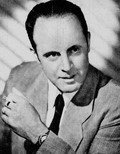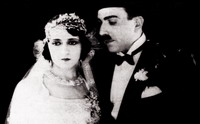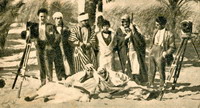Ibrahim Lama
(1904-1953)

Ibrahim Lama
(1904-1953)

Bahiga Hafez and Zaki Rustom in The Victims

The crew of A Kiss in the Desert
Ibrahim Lama was born in Chile, South America in 1904. In 1924, he decided together with his brother Badr Lama to return to his homeland, Palestine. On their way to Bethlehem, however, they stayed for a while in Alexandria. The cosmopolitan city seems to have appealed to them, for they decided to settle in it.
Back in Chile, Ibrahim had worked as an amateur photographer while his younger brother had worked as an assistant director in two short films. Drawing on their previous experience, they started working as photographers in Alexandria but quickly converted to cinema which was gathering momentum in Alexandria.
They joined the Association of the Supporters of Motion Pictures (Gamâ't Ansâr el Sowar el Mutaharika) which was founded by a number of amateurs in Alexandria and which eventually turned into a cinema company under the name of Mena Film. Soon, however, they withdrew from that company and established their own company, Condor Film.
The lives of the Lama Brothers were closely intertwined and so were their careers. In perfect harmony, the brothers divided labour amongst themselves from the outset: Ibrahim was to write and direct, while the good-looking Badr was to act. Josephine Sarkis, Ibrahim’s wife, who came to be known as Badriyya Raafat, was another member of the family who took part in this familial success by acting in their films.
Ibrahim wrote the script of his film debut A Kiss in the Desert (Qoublah fi-l-sahrâ’) and his brother Badr was to play the leading role opposite Yvonne Goeine. Ibrahim directed it in 1927 in a small-scale studio in a villa in the Victoria district in Alexandria. It took them six months to finish the film which was shot in deserts and natural locations. The film abounded with adventures, sword fights and chivalry as the Lama Brothers were influenced by Rudolf Valentino’s films.
This film aroused controversy for it was considered by some the first feature film produced by Egyptian cinema. However, Ahmed el Hadari dismisses this fact in his book Tarikh el Cinema fi misr, especially that all the news about this film in the newspapers reveal that it was not finished till the end of 1927 and then released in 1928. The film, thus, emerges as the third feature film in the history of Egyptian cinema after In the Land of Tutankhamun (In the Land of Tutankhamun) in 1923 by Victor Rossito and Laila (Laylah) in 1927 by Aziza Amir.
He was to make his second film A Tragedy on the Pyramid (Fâgui’ah fawq el haram) in 1928. Lama was a man of many hats for he directed, edited, acted, designed the set and wrote the script of the film, which starred Badr Lama and Fatma Rushdi. Nonetheless, this film was doomed for it not only failed in cinema theatres but was met with censure to the extent that Fatma Rushdi, out of fear for her reputation, withdrew from a film she had already started acting in.
In 1930, the two brothers moved to Cairo and established the first well-equipped studio under the name of the Lama Studio in Qoubbeh Gardens, Cairo.
Besides drawing on stories of knighthood and adventures for his films, Ibrahim also made social-oriented films such as Pricks of Conscience (Wakhz el damir)in 1931, The Victims (el Dahâyâ) in 1932, The Ghost of the Past (Chabah el mâdî)in 1934, Bewildered Souls (Noufous hâ’irah) in 1938 and A Man Torn between Two Women (Ragoul bayna imra’atayn) in 1940; he made a number of comic films such as The Miracle of Love (Mou‘guizat el houbb) 1931, Cairo Nights (Layâlî el Qahirah) in 1939, The False Bey (el Beh el mouzayyaf) in 1945; he also had a go at historical films: Saladin (Salah Eddine el Ayyoubî) in 1941, Cleopatra (Cléôbatra) in 1943 and Qaïs and Laila (Qays wa Layla) in 1939. Nevertheless, his historical films were characteristically weak due to deficient financing. Interestingly enough, while in 1941 Saladin was only worth a poorly designed adventure film produced by the Lama Brothers, twenty years later it was to turn into Youssef Chahine’s spectaclular Saladin (El Nâsir Salah Eddine) in 1963.
In 1947, Ibrahim Lama was dealt a blow as his brother Badr passed away after his return from America to which he had traveled to buy some equipment for their studio. He grieved over his dear brother for a long time but eventually managed to start over again. He was to replace his brother with Badr's son Samir Lama who was known as Samir Abdallah. Ibrahim was to make five adventure films starring Samir Abdallah. Two of those films, The Missing Link (el Halaqah el mafqoudah) and The Caravan moves Forward, (el Qâfilah tasir) were shot in the jungles of the Sudan and Kenya. Ibrahim is thus considered the first Arab director to tread that path.
On 14 May 1953, his life ended tragically as he shot himself and his beautiful young Greek wife dead. Rumour has it that he caught her in bed with another man.
Filmography:
1928: A Kiss in the Desert (Qoublah fi-l-sahrâ')
1928: A Tragedy on the Pyramid (Fâgui‛ah fawq el haram)
1931: The Miracle of Love (Mou‘guizat el houbb)
1931: Pricks of Conscience (Wakhz el damir)
1932: The Victims (el Dahâyâ) (Silent)
| 1932: The Victims (el Dahâyâ) (Silent) |
1934: The Ghost of the Past (Chabah el mâdî)
1935: Maarouf, the Bedouin (Ma'rouf el badawî)
1935: The Victims (el Dahâyâ) (Sound version)
1936: The Runaway (el Hârib)
1937: Just what's needed (‘Izz el talab)
1938: Bewildered Souls (Noufous hâ’irah)
1939: The Lost Treasure (el kanz el mafqoud)
1939: Nights of Cairo (Layâlî el Qahirah)
1939: Qaïs and Laila (Qays wa Layla)
1940: A Man Torn between Two Women (Ragoul bayna imra’atayn)
1940: A Cry in the Night (Sarkhah fi-llayl)
1941: Saladin (Salah Eddine el Ayyoubî)
1942: Child of the Desert (Ibn el sahrâ’)
1942: The Mysteries of Life (Khafâyâ el douniâ)
1943: Cleopatra (Cléôbatra)
1943: The Call of Blood (Nidâ’ el dam)
1944: Down with Love! (Yasqout el houbb)
1944: The Ideal Bridegroom (‘Arîs el hanâ)
1944: Wahida (Wahidah)
1945: The False Bey (el Beh el mouzayyaf)
1946: Daughter of the East (Bint el sharq)
1947: The Beautiful Bedouin (el Baddawiyyah el hasnâ’)
1947: The Treasure of Happiness (kanz el sa‘âdah)
1948: The Safe Road (Sikkat el salâmah)
1948: The Missing Link (el Halaqah el mafqoudah)
1951: A Storm in Spring (‘Âsifah fi-l-rabî')
1951: The Caravan Moves Forward (el Qâfilah tasir)
References:
- Daoud, Abdel Ghani. El Rahloun fe Ma̓at ‘Âm. Cairo: Wezârat el Thaqafah, 1997.
- El Hadari, Ahmed, Tarikh el Cinema fi Misr. 1896-1930. Cairo: Publications of the Cinema Club, 1989.
- Hassan, Elhami. Tarikh el Cinema el Misreyah. Cairo: Sondouk el Tanmeyah el Thaqafiyah, 1995.

